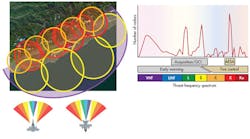GaN-Based AESAs Enable U.S. Navy’s Next-Generation Jammer
To match and even exceed the electronic-warfare (EW) capability of modern systems, the U.S. Navy has commissioned a $279.4-million contract to enhance the jamming features of the EA-18G Growler airframe. This decision came after a realization that the stealth capability of warfighters is dramatically reduced when confronted with the latest in radar technologies. Active jamming and other advanced EW techniques are necessary to maintain air superiority in the modern battlespace.
This file type includes high resolution graphics and schematics when applicable.
The contract called for standoff jamming technology that brings next-generation jamming assets to the U.S. Navy—hence the project name, the next-generation jammer or NGJ. Raytheon, which was awarded the contract, will implement a highly efficient AESA-based (actively electronically steered array) jamming system with powerful and wideband gallium-nitride (GaN) technology (Fig. 1).
The EA-18G is a variant of the F/A-18F Super Hornet Block II made by Boeing. The U.S. Navy commissioned it to replace the EA-6B Prowler aircraft. The goal of the upgrade is to present a platform for airborne electronic attacks (AEAs) that could adapt to the latest in EW requirements, which include suppression of enemy air defenses, stand-off/escort jamming, non-traditional electronic attack, self-protect/time-critical strike support, and continuous capability enhancement.
Such features rely on the ability to locate, record, replay, and jam hostile communications while tracking across an extremely broad frequency range. Maintaining the ability to communicate with allied forces while operating jamming electronics is another critical requirement.
“Stand-off jamming” implies another layer of defense separate from a self-protect system, which is only capable of individual aircraft defense or stand-in systems that only defend aircraft within a limited escort range. The stand-off system would be able to mask an entire fleet of airships from an extremely long range.
The Role Of NGJ
The NGJ is being designed to break the acquisition cycle of radar installations in the search or early-warning phase of detection. S-band radar installations are the threat most often considered, as they are used in most surface-to-air (SAM) missile systems and other anti-access/area denial (A2/AD) systems. “As that would be your queen on the board, you would want to protect those high-value assets. If you remove the Growlers, you remove the cover and everyone is exposed,” says Andy Lowery, the NGJ chief engineer for Raytheon
To provide these features, the current AN/ALQ-99 Tactical Jamming System (TJS) required replacement. The ALQ-99 is a ram-air, turbine-powered mid-band jamming array that uses mechanically steered technology. It comprises mostly analog technology and delivers turbine power to roughly 27 kW. The power conversion and RF-transmission electronics in the ALQ-99 were designed with older technology. As a result, it cannot use the turbine-generated power in a highly efficient manner. This limits both range and target suppression abilities.
To cover the ultra-high-frequency (UHF) to X-band range, the band-appropriate, mechanically steered antenna arrays require time-consuming installation. This missionization structure only allows a Growler to offer EW capability for a single narrow-frequency range. The NGJ program is designed to reinvent the methods used for jamming technology to eliminate these drawbacks.
“This particular program is completely on the other end of the spectrum. It taps into state-of-the-art technologies from tip to tail. It has a very advanced set of technologies and leverages brand new designs and developments,” notes Lowery.
Several global factors are contributing to the drive to improve the jamming systems of modern warfighters. For instance, the power and sensitivity of potentially hostile radar systems is allowing for much longer range as a byproduct of their increased signal-to-noise ratio (SNR). Today, more countries are producing large numbers of radar installations in dense configurations. The technological sophistication of these radar systems mitigates traditional stealth technology, due to improved signal-processing techniques and jamming avoidance.
To counter these feature enhancements, the NGJ upgrades the jamming capability of the EA-18G with GaN power/thermal-management systems. It uses the electronic scan nature of the AESAs to contend with numerous radar systems. At the same time, it increases back-end system capability with highly sophisticated computer control along with rapid reprogrammability.
The Components
Physically, the NGJ is composed of two pods attached to the port and starboard modular attachments of the Growler (Fig. 2). Each pod houses four AESA arrays with a full-bandwidth pair of arrays in both the front and back of each pod. One array in each pair covers the higher range of the bandwidth. The other array covers the lower end of the threat-band frequency range. This structure eliminates the need for missionization and costly reconfiguration.
The internal computer contains processors, technique generators, and a scope of receiver capabilities. A major advancement of the NGJ is that each of the AESAs can receive and transmit through the whole range of its frequency operation. Additionally, the arbitrary NGJ signal generation offers a wide range of signals that can be transmitted through the apertures and arrays.
Polarization is another control method that the signal generators can perform. It enables the NGJ to perform smart jamming functions. In those scenarios, the NGJ can receive signals from a specified threat and respond to information gathered from those signals with counter-jamming action (Fig. 3). Such actions do not rely on control from the EA-18G techniques generator or electronic support measures (ESMs).
The array modules include electronics that use GaN high-power amplifiers (HPAs). Those amplifiers drive the power signals through the circulators and apertures to the array elements. The AESAs can therefore form high-energy RF beams with advanced signal capability that can be steered by a highly advanced and rapidly reprogrammable computer.
“Due to the nature of it being an AESA, you can form many beams or a super beam with a lot of energy. It is agile, so you can dart from one system to another system on the ground almost instantaneously,” says Lowery.
The computers driving the NGJ system also communicate with the Growler’s common electronics unit (CEU), which has the enhanced ability to link with military-communications networks. In essence, this makes the NGJ system an extremely mobile, high-power, wideband, networked, and steerable long-range software-defined radio (SDR). There are many potential applications for the NGJ system, although currently the NGJ is geared specifically for jamming.
In addition, each pod is a fully self-sustaining system capable of generating its own highly efficient power, cooling, and transmission. The pods require no ship-generated power or resources other than instructions. An edge in efficiency is acquired by using a submerged ram-air turbine technique that enables air power to be extracted. The articulating cores can be completely enclosed during flight, which creates an extremely streamlined pod design for lower drag.
“When they are ready for a jamming mission, it can deploy taking in air and produce an excess of three times more power from the airstream than the ALQ-99,” Lowery says.
Once this air-based mechanical energy is converted to AC electrical energy, it is converted into high-voltage DC. Another conversion produces low-voltage DC power primarily for the GaN-based electronics driving the four arrays and the intelligent subsystems.
Working With GaN
Raytheon has been developing GaN technology for 15 years. In addition to delivering higher frequency, bandwidth, and power from RF devices that are defense-ready, GaN technology offers a much smaller footprint, larger wafer sizes, increased yields, and higher efficiencies. Currently, Raytheon is manufacturing its GaN circuits in its foundry in Andover, Mass. The Pentagon awarded this foundry with a manufacturing readiness level (MRL) of eight, which is the highest rating for any organization in the defense industry for that technology sector.
All of GaN technology’s strengths make it a very attractive solution for defense applications, which may have been a key factor in Raytheon winning the NGJ contract. Of course, the benefits of GaN technology don’t come without critical design considerations. Working with extremely high-frequency and high-power components in a very dense space requires the dissipating of heat that is produced by its operation, preventing poor efficiencies and device failure.
“If you can’t spread the heat, the device will burn itself out. Or you will at least have to back off the power and not use the device to its full potential,” says Lowery.
The cooling system used in the NGJ is based on a single-phase system similar to a car-radiator fluid system. But it boasts far greater sophistication and more modern design. This type of thermal-management system was chosen for its robust nature. It can operate reliably across a wide range of environmental conditions.
Additionally, the design lends itself to very high heat dissipation for its size. Stock cold plates with advanced adhesives are used to sink the thermal energy from the AESA. The thermal energy is further spread throughout a larger heat-dissipation system using an ethylene-glycol and water-mixture-based liquid.
The amount of heat flux generated by the latest GaN devices in such a small area could approach and exceed the heat flux of a nuclear explosion, making the heat-dissipating technology critically important. This is a more exaggerated problem with GaN devices compared to gallium-arsenide (GaAs) devices, due to GaN technology having power density and bandwidth capacity that is many times greater than GaAs. Research and development is still being invested in discovering the best performing adhesives and thermal spreaders.
The goal of the thermal-management system is to provide a secure fixture under extreme G-forces and excellent grounding while spreading the heat from the pinpoint generation zones of the GaN devices. Diamond thermal spreaders are of particular interest, as they have extremely high thermal conductivity. Using diamond as a semiconductor substrate for a GaN-on-diamond insulator process could solve many of the thermal stress issues that arise with GaN technology.
Testing The System
Such a sophisticated and configurable system, which will be deployed in an extreme environment, also faces a challenge in testing prior to production. Many of the subsystems can be tested in an isolated environment. When the subsystems are compiled into a larger structure, however, the nature of the system makes it a daunting testing scenario.
“When you start to multiply all of the states that a single beam can have across all of those dimensions, you end up getting a huge amount of data points. Each state would have to be calibrated and configured when making the AESA,” says Lowery.
The Combat Electromagnetic Environment Simulator (CEESIM) offered by Northrop Grumman is one of the only test systems that is configurable and sophisticated enough to test such a complex device. Considering the AESA’s exceptional configurability and power offerings, there are few systems that can effectively test the NGJ while emulating operating modes.
“The other factor is the anechoic chamber. It would have to be able to handle this fire-breathing dragon of an AESA that operates under CW (continuous wave) conditions and is able to transmit a massive frequency swath,” says Lowery.
This test complexity increases when testing the ram-air turbine system while operating the AESA. Currently, no known test system can test a device in an anechoic chamber with the necessary power requirements and a 400-mph wind tunnel with a CEESIM/pulse generator.
The U.S. Navy is undertaking a great deal of test-range development to help tackle these challenges. In fact, an anechoic chamber with enough power handling and sensors to characterize the AESA is currently being constructed. A potential option to test the NGJ is to mount a full-sized Growler upside down on a pole equipped with a complete NGJ system to test for RF character, physical blockages, or interference with the installed configuration.
Presently, discussions of the testing system are underway. Answering these complex test questions is the topic at hand. As part of the Interface Working Group initiative, test planning and development with the Navy, Boeing, Northrop Grumman, and Raytheon is currently being investigated to effectively test for and prevent any co-site issues that would limit the operation of the NGJ and similar systems.
About the Author
Jean-Jacques DeLisle
Jean-Jacques graduated from the Rochester Institute of Technology, where he completed his Master of Science in Electrical Engineering. In his studies, Jean-Jacques focused on Control Systems Design, Mixed-Signal IC Design, and RF Design. His research focus was in smart-sensor platform design for RF connector applications for the telecommunications industry. During his research, Jean-Jacques developed a passion for the field of RF/microwaves and expanded his knowledge by doing R&D for the telecommunications industry.




